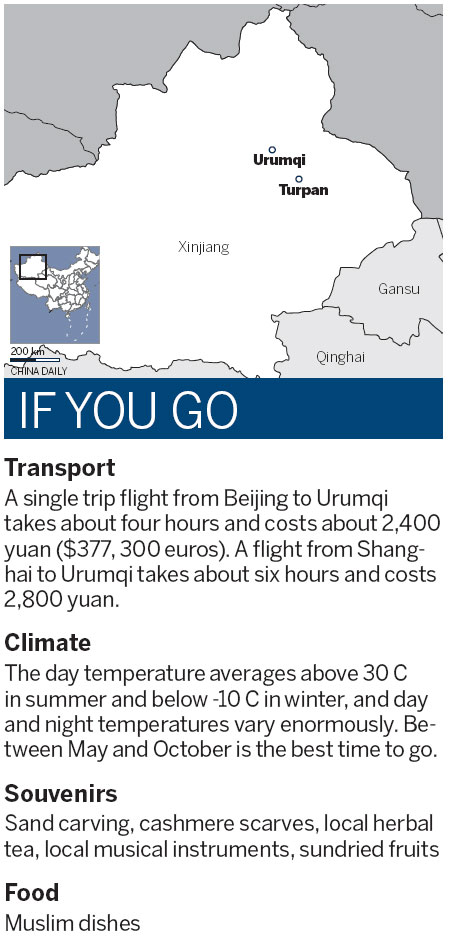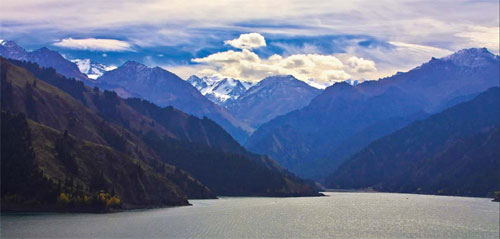Allure of a remote gem
Updated: 2012-06-29 12:50
(China Daily)
|
|||||||||||
|
With an average altitude of about 5,000 meters, Tianshan Mountain is a spectacular sight, with terrain that varies widely from base to peak. Liu Jie / For China Daily |

Scenic beauty and heat are regular companions in and around Urumqi, but the sea is a distant friend
Urumqi, which means "beautiful pasture" in ancient Junggar Mongolian, is located in the north of the Xinjiang Uygur autonomous region. Stretching along the northern foot of Tianshan Mountain and the southern edge of Junggar Basin, the city has made a name for itself as much for its flourishing economy as for its exotic allure.
Last year the city's GDP rose 17.1 percent to 170 billion yuan ($27 billion, 21 billion euros), the highest in 23 years, and the value of imports and exports totaled $9 billion, an increase of 49 percent on the previous year.
Of all the world's cities, Urumqi is the farthest from the sea, about 2,500 km from the nearest coastline. It has long been an important gateway to Central Asia and Europe by land, and a cultural bridge between the East and the West.
The area was populated as early as in the Neolithic Age, about 10,000 years ago, but the city's real prosperity began during the Qing Dynasty (1644-1911), when the empire brought in people from eastern regions and built settlements to guard the frontier.
Since then Urumqi has become a major agricultural center, producing cotton, grapes and beets for the country.
Based on the data of the sixth national population census, much of Xinjiang is sparsely populated, but Urumqi has a population of about 3 million, one-seventh of the total population in the region. The city's population is made up of about 50 ethnic groups, including Uygur, Hui and Han.
For those attracted to a city surrounded by desert and blessed with exquisite scenery, Urumqi is hard to beat. Here are a few ideas on what you could do if you go there.
1. Tianshan Mountain
Ranging through central Xinjiang, Tianshan Mountain extends 1,700 km, the western-most end stretching into Kazakhstan. With an average altitude of about 5,000 meters, the mountain is a spectacular sight, with terrain that varies widely from base to peak.
While the foot of the mountain is shod with thick green pine trees, half way up meadow steppes begin, and all of this is capped with Bogda Peak, decked in a blanket of snow all year round.
About 2,000 meters up the mountain is a crystal clear lake called Tianchi, or Heavenly Lake, said to have been formed by ice and snow melted from the mountain.
On sunny days the lake offers a breathtaking sight as the snow-white peak and the emerald green trees seem to preen themselves, using the lake as a gigantic mirror. To get a close-up look you can rent a paddleboat and lap up the beauty of the reflected green hills and colorful wild flowers as a gentle breeze accompanies you across the water. It is all the more enjoyable as a summer getaway, when the temperature in the city can easily reach 38 C.
2. Turpan
The city is about three hours' drive from Urumqi. Best known for its delicious and wide variety of grapes, it is the center of a fertile oasis, with water resources obtained from a series of dug wells that are linked by underground canals to collect water from the melted ice and snow of Tianshan Mountain.
Flaming Mountain is a must-visit site in this extremely hot basin area. The mountain first appeared in the Chinese classic novel Journey to the West and became a household name.
The surface temperature at the foot of the mountain can reach 80 C. In fact the heat is so intense that from a distance, and because of the red soil, you might well think that you are looking at flames.
Located along the Silk Road's northern route, Turpan is an ancient city with many relics well preserved. The remains of the old city of Jiaohe, 13 km west of Turpan, date back to the Western Han Dynasty (206 BC-AD 24), and are said to be the oldest clay construction of their type in the world.
3. Grand Bazaar
The Xinjiang International Grand Bazaar in Urumqi was completed in June 2003 and is among the biggest bazaars in the world, as well as a good place to collect souvenirs.
In its buildings there are typical Islamic design elements, including a round dome, but there is a heavily modern touch as well.
The 40,000-square-meter bazaar has hundreds of restaurants, theaters and souvenir shops. Among many other things, tourists can find local specialties from herbal tea, cashmere scarves with rich Turkish patterns, handmade knives and musical instruments.
Eating and drinking
The ethnic melting pot that is Urumqi includes a sizeable proportion of Muslims, and alcoholic drinks are prohibited in many restaurants. One possible substitute is tea with milk, a perfect match with naan bread, a staple food of the Uygur and Kazak people.
Muslim food is served on big plates and in generous proportions, so a serving of chicken and lamb with a naan will be enough to satiate the hungriest group of four. Lamb hung and roasted on an iron hook, and then dipped in cumin, is a specialty.
China Daily
(China Daily 06/29/2012 page22)
Today's Top News
Rescuers race against time for quake victims
Telecom workers restore links
Coal mine blast kills 18 in Jilin
Intl scholarship puts China on the map
More bird flu patients discharged
Gold loses sheen, but still a safe bet
US 'turns blind eye to human rights'
Telecom workers restore links
Hot Topics
Lunar probe , China growth forecasts, Emission rules get tougher, China seen through 'colored lens', International board,
Editor's Picks

|

|

|

|

|

|






